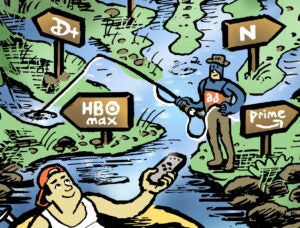 Imagine starting as VP of marketing for a restaurant chain on the same day restaurants were forced to shut down at the start of the pandemic.
Imagine starting as VP of marketing for a restaurant chain on the same day restaurants were forced to shut down at the start of the pandemic.
Andrew Hagen knows what that’s like. He joined Noodles & Company, a quick-serve noodle restaurant chain based in Colorado, as VP of marketing two years ago – the very same day restaurants closed in Colorado.
Since then, Noodles & Company’s marketing has gone through a massive overhaul, with tests of new vendors, experimentation with new media channels and a fresh focus on – you guessed it – first-party customer data.
One of the most important changes was a revamp of the company’s rewards program.
Part of Hagen’s remit when he joined Noodles was to lead first-party data collection efforts, especially from new app-based loyalty members. He previously held a similar role for Vail Resorts, where he worked on the famous ski mountain membership the Epic Pass, which was created by Vail.
Noodles & Company first started a rewards program in 2017, but for the first few years the goal was mainly to “surprise and delight” customers with random freebies or upgrades, Hagen said. In late 2019, it became a points-based program which, according to Hagen, reached one million loyalty members at the start of this year.
The switch to using reward points means customers directly benefit when they order more and more often. Noodles & Co also gamifies its loyalty program with tiers and additional benefits that can be unlocked.
But the most significant aspect of the program’s transformation is mental, going from serving up random benefits to a system “based on personalized [and] targeted offers to individual guests,” Hagen said.
Good point
Noodles & Company isn’t the first quick-serve chain to make this same transition when it comes to loyalty marketing. Chipotle once had random free burritos for customers who drew the lucky foil (the burrito wrapper). Since the pandemic began, it’s invested heavily in a rewards-based loyalty app.
Points-based rewards don’t just offer a cleaner value prop to loyal customers, but also represent a valuable shift for the business, Hagen said, because the loyalty program generates a multipurpose first-party data set. If Noodles is testing new items on its menu, for example, the loyalty program is the best way to measure success because it’s a group of known individuals who have given consent for their data to be used for analytics and other purposes.
Although in some ways it’s easier to get people to sign up for a “surprise and delight”-style loyalty program, the rewards aren’t as good for the company.
A program that isn’t personalized doesn’t need to be anchored by an authenticated real-world identity, such as a phone number and email. Someone can just show up, sign up and receive the bennies. A points-based (aka, data-based) loyalty program, on the other hand, requires shuffling customers through an app install process.
But once a company lands a new member, it’s got an anchored profile to which it can append all sorts of other data, including online advertising identity data and purchase data.
Test and learn
Noodles & Company’s renewed focus on its loyalty program coincides with a marketing strategy that involved moving into multiple new media channels.
App-install acquisition marketing is an unsurprising one, since Noodles now has an app of its own and is hungry for installs. But it’s also recently added CTV and TikTok and plans to test data-driven out-of-home media offerings for the first time this year, Hagen said.
The company’s expansion into channels like CTV and TikTok is directly tied to its loyalty program revamp. Although they aren’t particularly strong traffic drivers for the program, Hagen said, tracking and analyzing reward members is the main way Noodle & Company can “understand different segments and personas to target within portable media spaces,” Hagen said.
In plain English: Its rewards members are the core data set Noodles uses to create lookalike audiences based on behaviors or demographics it’s targeting.
But its appetite for testing is not just on media. The chain has also added and evaluated many new vendors centered around its loyalty and first-party data program. For instance, Noodles & Co added the marketing vendor Movable Ink, which works with the chain to personalize email communications. Another new vendor is Branch, the mobile deep linking and analytics service.
The loyalty program is only becoming more central to Noodles’ marketing strategy as signal loss becomes a bigger challenge for the industry overall. Other data sources, such as online advertising or outside data vendors that use emails to match anonymous profiles, are more and more often “masked by privacy proxies,” he said.
Apple’s AppTrackingTransparency (ATT) framework, for instance, blocks many emails that otherwise could be used for syncing so Noodles & Co would know that a subscriber to one news site or another app is a match to its known customer. Those connections are less common now, because Apple doesn’t allow cross-app or app-to-web tracking. But with a larger first-party data set – and more customers opting in to allow tracking through the loyalty program – the linkages can return.
A first-party data set is like a spiderweb. It doesn’t need to cover everything but, at some point, the web reaches a critical mass and flies start getting stuck.
Noodles & Co is now in the process of testing more potential vendors for media analytics without third-party cookies, Hagen said, which is the next big change on the horizon after ATT.
“These changes absolutely affect our day to day already,” he said of the pending deprecation of third-party cookies in Chrome and Google Android’s coming restrictions on ad tracking.
“It’s a huge part of why we’re focused on first-party data and driving up the reward member population,” Hagen said. “We know the value of that data.”














